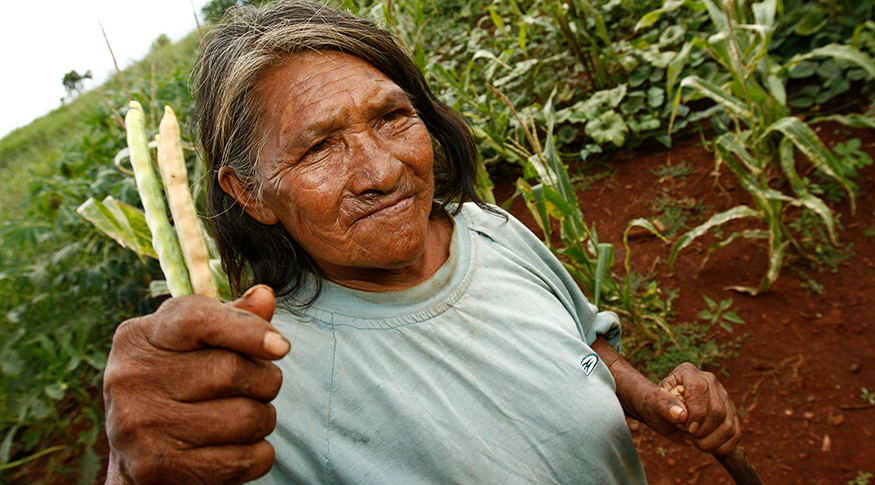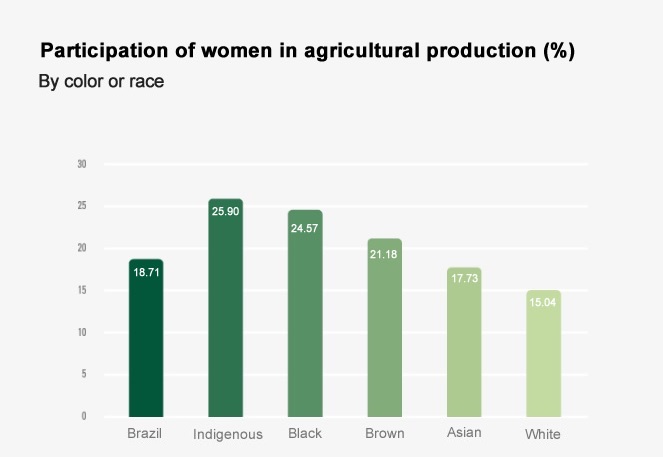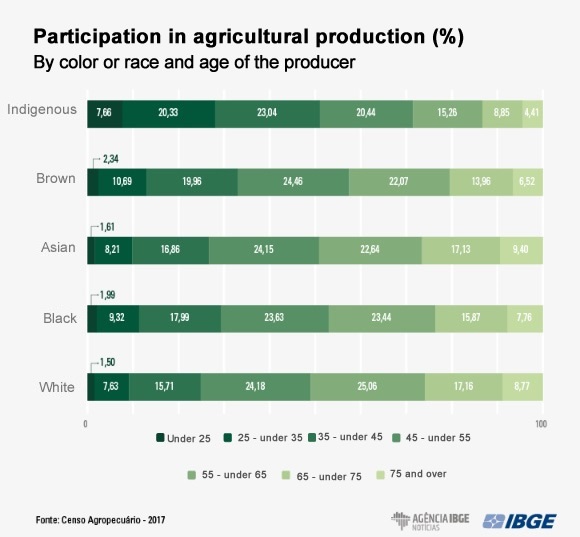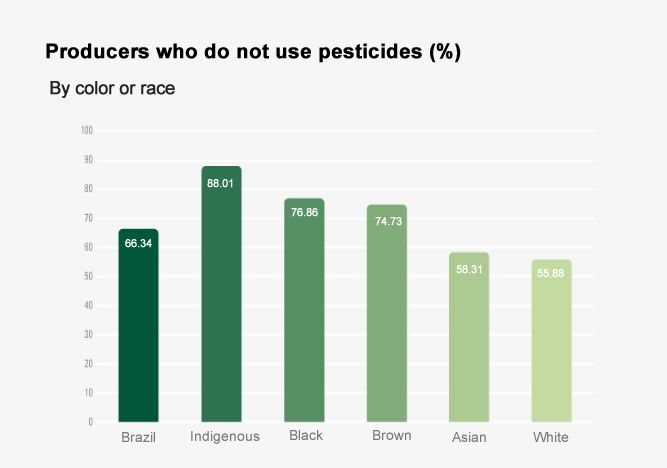Census of Agriculture 2017
Indigenous population has diversified agricultural production, with a majority of women producers and less pesticide use
December 14, 2022 10h00 AM | Last Updated: December 16, 2022 12h03 AM
Highlights
- Data from the 2017 Census of Agriculture show that the North Region holds the highest proportion of Indigenous rural producers (5%). Among the states, Roraima (33.5%), Amazonas (20.43%) and Amapá (10.96%) have the highest percentages.
- Indigenous-managed establishments have a higher proportion of women in their administration (25.90%). In addition to that, 27.99% of Indigenous producers are under 35 years of age.
- As for horticulture, establishments with Indigenous producers stood out due to the production of pepper, whereas among groups of another color or race, lettuce was the main product.
- The most commonly cultivated temporary crop among Indigenous people is manioc, whereas in the case of white, black or browns and Asian persons, corn grain is.
- About 88.01% of the establishments managed by Indigenous people do not use pesticides, the highest proportion among the five groups of producer color or race. On the other hand, only 8.4% of these establishments were given tecnhical assistance and guidance, the lowest proportion.
- Black or brown producers or spouses are present in 55.12% of the establishments enumerated, with highest proportions observed in the Northeast (74.2%) and North (73.50%). State highlights are Pará (80.84%), Piauí (80.28%) and Bahia (76.43%)
- The 2017 Census of Agriculture investigated, for the first time, the color or race of producers and their spouses, thus providing disaggregated statistics, with results by Indigenous Land and some categories of Conservation Units.

The IBGE releases today a new module of the 2017 Census of Agriculture,, with detals about the main characteristics of agricultural and extractive activities, by groups of color or race of producers. The publication also presents analyses by specific territitories, about Indigenous Lands spread all over the country and for some Conservation Units - Extractive Reserves (RESEX), Sustainable Development Reserves (SDR) and National, State and Municipal Forests.
Among the 5.1 million producers enumerated by the 2017 Census of Agriculture, 45.43% identified themselves as white, 44.47% as brown; 8.37% as black; 1.12% as Indigenous and 0.62% as Asian. The biggest percentages of Indigenous producers were in the North (5.0%) and Central West (1.29%). Among Federation Unit, Roraima (33.63%), Amazonas (20.43%), Amapá (10.96%), Acre (6.09%) and Mato Grosso do Sul (4.52%) had the biggest proportions of Indigenous producers.
The Northeast and North are the regions with the buggest proportions of producers of black color or race, respectively, 11.65% and 9.65%. Among the states, the highlights are Bahia (15.75%), Amapá (14.63%), Maranhão (14.14%), Tocantins (13.55%) and Piauí (12.41%).

Establishments with Indigenous producershave had the highest rates of women’s participation among producers (25.90%), followed by black (24.57%) and brown (21.18%) producers. About 27.99% of the Indigenous producers are under 35 years of age. The average age of Indigenous producers is 45.4 years, whereas white producers are, on average, 54.7, followed by Asian, 54,3 years of age, black, 53.2 and brown producers, 51.7 years of age.

Establishments managed gy black or brown producers or their spouses make up 55.12% of the enumerated establishments, with highest propostions in the Northeast (74.42%) and North (73.50%). Among the states, Pará (80.84%), Piauí (80.28%) and Bahia (76.43%) stood out.
The highest percentages of employed persons related to the producer are in establishments with Indigenous (93.07%), black (86.28%) and brown (82.59%) producers, whereas the lowest percentages are in establishments with self-identified Asian producers (54.10%) and self-identified white ones (70.61%).
According to Marta Antunes, coordinator of the Census of Traditional Peoples and Communities, family work is a characteristics of indigenous peoples. “That is mostly observed in establishments focused on subsistence. In establishments managed by indigenous persons there was a bigger variety of products, wich results in more food security for these families,” Ms Antunes explains. In 67.08% of the agricultural establishments in Indigenous Lands, the main purpose of horticulture production is consulption by producers and their families. Among the total establishments found by the 2017 Census of Agriculture, this percentage is lower (43.54%).
Indigenous agriculture: less pesticide use, more product diversity
The 2017 Census of Agriculture shows that the establishments directed by Indigenous persons have a more diversified production (43.24% classified as diversified and very diversified), according to the classification of the Food and Agriculture Organization of the United Nations – FAO, whereas in establishments whose producers were self-identified Asian production is more specific (29.89% classified as super specific), that is, concentrated into a smaller range of products.

88.01% of the establishments directed by Indigenous did not use pesticides This rate is lower in establishments managed by black (76.86%), brown (74.73%), Asian (59.56%) and white (55.88%) producers.
In establishments with Indigenous producers, only 8.4% reported having received guidance and assistance from a technical expert in agriculture. Together with those managed by black (9.57%) and brown (10.83%) producers, these establishments were significantly less provided with technical assistance than those directed by white (31.12%) and Asian (28.03%) producers.
Indigenous producers are those that most often use ordinary seeds produced by themselves (74%), followed by black and brown (both with 53%), white (36%) and Asian (31%) producers.
Pepper and manioc are the most common products in establishments managed by Indigenous persons
In horticulture, the most commonly found products in establishments managed by Indigenous persons are pepper, yam and sweet potato, whereas producers of other four groups of color or race favored lettuce.
In temporary crops, the products most commonly found in establishments in establishments managed by Indigenous persons are, in decreasing orded, manioc, corn grain, pinneaple and black-eyed peas, which makes them different from other producers: white producers with corn grain, manioc, black-eyed peas and soybean seed; black producers with corn grain, manioc, black-eyed peas, manioc and black beans; and Asians with corn grain, manioc, black-eyed peas and soybean seed.
In non-wood harvesting, among white producers, the main products are yerba mate, acai (berry) and pine nuts; acai (berry) and pine nut; among black producers, the most common ones are acai (berry), babassu (nut and coconut) and umbu (fruit); among brown producers, acai (berry), babassu (nut and coconut) and Brazil nut; and Asian producers, acai (berry), babassu (nut) and umbu (fruit); and Indigenous producers, acai, Brazil nut, bacaba and buriti.
Wild crop harvesting is a highlight in Indigenous Lands
The 2017 Census of Agriculture shows that there is a bigger relevance of Indigenous Lands, where 45.15% of the producers have this activity. Among the establishments out of these locations, the rate is only 8.86%.
In Indigenous Lands, 81.52% of the establishments have temporary crops and 54.13%, permanent crops. These two proportions, among the establishments out of the Indigenous Lands are 59.44% and 31.23%, respectively.
About 19.34% of the establishments in indigenous lands are directed by producers that are not indigenous. In the South Region, this percentage reaches 30.33%. Among the establishments with Indigenous producers or spouses, 69.31% re inside indigenous lands.
AM, AC and PA hold 81.4% of the establishments with Conservation Units
Agricultural establishments located in the RESEX, RDS and Forests for Sustainable Use are concentrated in the North Region (90.22%), with 81.04% of the establishments concnetrated in three states – Amazonas, Acre and Pará. In these areas, among agricultural establishments directed to forestry production, in 98.70% the work is done in native forests, whereas out of the RESEX, RDS and Forests for Sustainable Development this percentage is 67.30%.
In these units, black, brow and indigenous producers, account, together, for 85.42%, being most of them brown ones (70.99%). In these areas, indigenous producers are responsible for 5.83% of the establishments.
A continuous study, with the inclusion of data over time
According to Ms. Antunes, the study results from society’s need to understand the agricultural production of traditional populations, mainly of indigenous peoples and extractivism agents, as well as other black and brown producers. “With this publication, we can unserstand what tells apart indigenous from non-indigenous establishments, and also identify characteristics of establishments and producers from other traditional territories. Partially in accordance with provisions in Decree 8,750/2016, by producing official statistics about Indigenous peoples and wild harvesting.”
It is the first time the Census of Agriculture has investigated the color or race of producers and theis spouses, with analyses by Indigenous Lands and Conservation Units. The objective was to make available detailed information about these topics, in order to fulfill the need of monitoring of targets in the UN 2030 Agenda for Sustainable Development Goals, of the Montevideo Consensus on Population and Development and of the National Strategic Plan for Protected Areas.




















